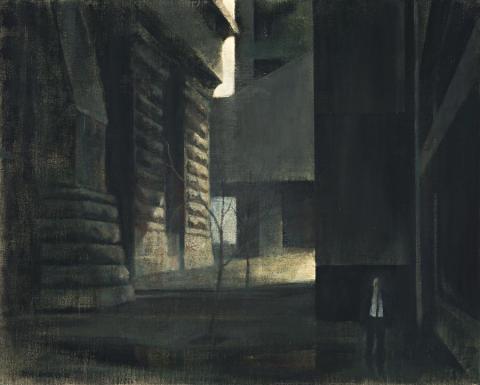STUDY FOR 'THE SECRET CITY', 1993-2001
RICK AMOR
oil on canvas
61.0 x 76.0 cm
inscribed verso: STUDY FOR / THE SECRET CITY / SEP 93 / DEC 00 / FEB 01/ 61 x 76
Private collection, Melbourne
The Secret City, 1993–94, 130.0 x 162.0 cm, in Fry, G., Rick Amor, Beagle Press, Sydney, 2008, p. 53 (illus.)
'What I am really interested in is the secret city. I've always thought that behind the façade of a building all sorts of mysterious things go on. I suppose it's from my childhood and reading Kafka. I like to suggest that behind prosaic realities something else is lurking.'1
The defining element in Rick Amor's landscapes, and more particularly his cityscapes, is the sense of that which is untold and unrevealed. He is the master of transforming the everyday subject and evincing the ambiguities inherent in life and in doing so he taps a rich seam of humanity's complex existence. Study for the Secret City also contains other classic Amor leitmotifs such as the notion of the isolated individual somehow at odds with his environment and the sense of foreboding and portent in the dark spaces of the artist's landscape.
According to the artist, the full scale painting The Secret City 1993-94 and its study depict a fictional Melbourne place, a dark capriccio of any number of locations throughout the city where new buildings are juxtaposed against their historic counterparts. Study for The Secret City was painted over the course of eight years between 1993 to 2001. During that period Amor was awarded three Australia Council residencies to Barcelona (1991), New York (1996) and London (2000) and it seems probable that these experiences have influenced the development of the study in which we observe an even greater ambiguity in the chiaroscuro effects in the composition. Both paintings were commenced after the Barcelona residency and from this period vestiges of the antique city appear in his paintings and a sense of a decayed past recurs, particularly in his cityscapes. In the study the heavy modern architecture remains in the shadows and this creates a deeper sense of foreboding. The suited figure in the foreground, although faceless is the embodiment of Amor's solitary individual, alone and dissociated in his environment. He appears to have evolved fully formed from both the New York and London experience.
1. Amor cited in Fry, G., Rick Amor, The Beagle Press, Melbourne, 2008, p. 54
LARA NICHOLLS
